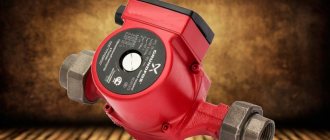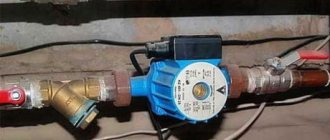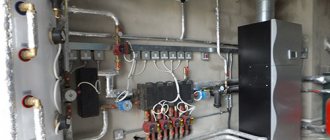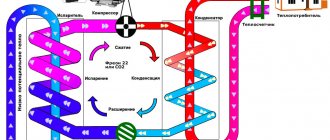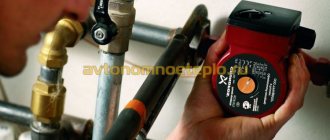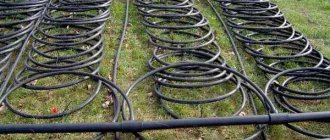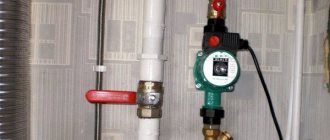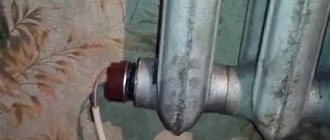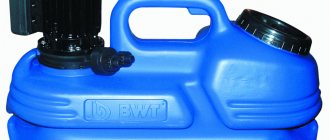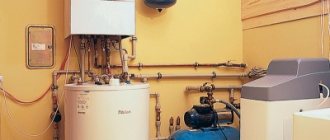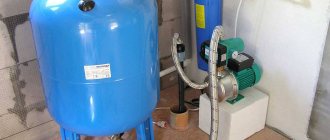Electrical repair
The electrical part of the pump includes the following components:
- inductor;
- starting capacitor;
- connecting wires;
- control terminal.
If the stator winding breaks down, the pump becomes unrepairable; all other components can be repaired or replaced. To analyze the condition of electrical parts, you will need an ohmmeter.
Photo of the circulation pump Wilo MTSL 15/5 HE – 2.
Main symptoms of malfunction
If the boiler display shows an error code corresponding to a water circulation problem, and it is not reset, the problem may be hidden in the electronic part of the device.
Circulation pump with cover removed.
To identify the problem you must:
- Turn off the heating mode in the boiler, and after stopping all components, turn off the power (soft stop).
- Open the front panel of the case.
- If the pump is covered with a large layer of dust, clean its surface.
- Using the information in the diagram, remove the control terminals and remove the terminal with the capacitor.
- Visually examine the condition of the pump contacts and terminals; they should be free of oxides, burnouts and mechanical damage.
- Using a tester in diode testing mode, determine the integrity of the connecting wires that go from the control board to the pump.
- Use an ohmmeter to determine the resistance of the inductors. On a working device, the instrument readings on the contacts will correspond to the following values:
- No. 1, 4 – 150 – 160 Ohm;
- No. 1, 6 – 290 – 300 Ohm;
- No. 2, 3 - 0 (contacts connected together);
- No. 3, 5 – 220 -230 Ohm;
- No. 4, 6 – 150 – 160 Ohm.
- The device will be considered faulty if the ohmmeter reading on any of the above pair of marks is 1 (winding wire break) or 0 (short circuit, except for contacts 2,3).
- Check the condition of the starting capacitor. To do this, switch the tester regulator to the 20 microfarad capacity test mode. Connect the probes of the device to the terminals of the capacitor and determine its capacitance. It should match the nominal ± 10%. Loss of capacity leads to a decrease in pump performance; it will emit an uncharacteristic hum.
Electrical diagram of the pump Wilo MTSL 15/5 HE – 2.
Measuring the resistance of the circulation pump windings.
Power connection
The circulation pumps operate from a 220 V network. The connection is standard; a separate power supply line with a circuit breaker is desirable. The connection requires three wires - phase, neutral and ground.
Circulation pump electrical connection diagram
The connection to the network itself can be organized using a three-pin socket and plug. This connection method is used if the pump comes with a connected power wire. It can also be connected via a terminal block or directly with a cable to the terminals.
The terminals are located under a plastic cover. We remove it by unscrewing several bolts and find three connectors. They are usually labeled (the pictograms are N - neutral wire, L - phase, and “ground” has an international designation), so it’s hard to make a mistake.
Where to connect the power cable
Since the entire system depends on the performance of the circulation pump, it makes sense to make a backup power supply - install a stabilizer with connected batteries. With such a power supply system, everything will work for several days, since the pump itself and the boiler automation “pulls” electricity to a maximum of 250-300 W. But when organizing, you need to calculate everything and select the battery capacity. The disadvantage of such a system is the need to ensure that the batteries do not discharge.
How to connect a circulator to electricity through a stabilizer
The performance of the heating system in many multi-story buildings cannot be called satisfactory. This is due to the small diameter of the pipes used through which the water flows and the pressure being too low. If you solve the second problem, then you won’t have to think too much about problem number one, since with the help of a good circulation pump it will be possible to ensure normal movement of the media along the wiring, thus increasing the performance of the entire system.
Design features
Products from German manufacturers can work for a very long time without maintenance. And all because durable and reliable materials are used in its production. For example, the body of the product is made of durable gray cast iron. Inside it is a stainless steel shaft. It is secured using bearings made of graphite. The fluid supply speed has three-stage adjustment. In this case, the maximum possible coolant temperature parameters can reach +110 degrees Celsius. In industrial models, this ceiling may increase.
Note! The described pump is also designed for very high operating pressure. Standard products used in everyday life can withstand a pressure of 10 bar
Industrial designs in special designs can withstand pressures of 16 bar.
Manufacturer information
A group of companies under the name "WILO" is considered the market leader in pumping equipment used in everyday life and in various industries. This association began its work back in 1872, when its founder L. Uplander opened a hardware store. Today, WILO is a leading manufacturer of pumping units that are in high demand in various fields. Thanks to the use of highly efficient energy-saving technologies, it is able to produce high-quality equipment that fully complies with European standards.
Over time, the company opened many representative offices with offices around the world. Their total number reaches 60 units.
On the domestic market, this manufacturer is represented by the VILO RUS division, founded in 1997. It now has about 30 branches, and in 2021 a service center was opened, specializing exclusively in servicing WILO products.
The main task of the company’s management and specialists is to launch the production of the latest equipment that would make people’s lives more comfortable. At the same time, all models produced by the company are characterized by high reliability and expanded functionality combined with excellent technical performance.
Operating principle of the Wilo MTSL 155 HE 2 circulation pump
The main part of the pump is an electric motor, consisting of a stator with several inductance coils to regulate the rotation speed, and a rotor, which is integrated on a shaft with bearings.
When power is applied to one of the stator windings, an electric field is created that drives the rotor with the turbine. The turbine blades capture fluid from the suction pipe and move it along the outlet pipe. In this way, the coolant circulates throughout the entire heating circuit.
Let's look at the main reasons leading to failure of the Wilo MTSL 15/5 HE - 2 pump.
Unstable voltage in the network
With reduced power, the pump motor slows down until it stops completely. With increased voltage, the inductor coils heat up, which can cause an interturn short circuit or burnout of the winding wire.
Contamination of pump mechanisms
When the liquid temperature is more than 60 ᵒC, scale may form on the turbine and shaft, which will slow down the rotation of the motor armature. Causes of pump jamming can also be increased oxidation of the driving mechanisms or the ingress of foreign objects.
Poor quality component material
If the pump uses parts made from low-quality materials, its service life is sharply reduced. For example, a shaft begins to jam due to the formation of a layer of rust on the surface of the bearings, because they are made of bronze, which contains iron. Such symptoms are typical for a non-original model.
Improper use of the device
Water through a working pump must constantly circulate at a certain speed. If the flow of the coolant is disrupted (the return or supply valve is closed, the system filter is clogged, etc.), the bearings and inductors in the device will overheat - this will lead to jamming of the rotor, breakage or short circuit of the stator winding.
The Wilo MTSL 15/5 HE - 2 circulation pump cannot be used when there is no water in the pipeline. But since Ariston double-circuit automatic units are equipped with liquid pressure sensors, the boiler will not turn on if there is no water in the system or its pressure is low.
How to install wilo heating pump correctly
The circulation pump increases the efficiency of the autonomous heating system and allows 100% use of all heating circuits.
Professional installation of a heating pump guarantees high performance, reduces operating noise and reduces maintenance and repair costs.
Previously, circulation pumps were used only in centralized heating systems, and for private housing construction the natural movement of the coolant caused by temperature differences was the norm.
Now forced circulation is used everywhere thanks to the emergence of compact and inexpensive models designed to service the heating networks of small houses and cottages.
Due to the increase in the speed of movement of the coolant in the pipeline, thermal energy flows faster to the heating radiators, and accordingly, the rooms are warmed up faster. The load on the boiler has decreased because the water is also heated faster.
The need to install bulky and inconvenient large-diameter pipelines has disappeared; contours have become easier to camouflage under floor coverings or be buried in walls.
The main disadvantage of pumps for heating systems is their dependence on electricity. If the power supply is intermittent or there is a risk of a complete power outage for some period, it is necessary to install a backup power generator or at least an uninterruptible power supply.
The remaining disadvantages relate to the designs and functionality of various types of devices. For example, monoblock units and devices with a dry rotor are noisier and require constant maintenance, while a pump with a wet rotor is demanding on the quality of the coolant and has a pressure limitation.
All installation efforts will be reduced to zero if the equipment is selected incorrectly. In order not to make a mistake, it is necessary to first analyze all aspects of a particular heating system and make the necessary calculations.
According to their design features, all devices are divided into 2 categories: with a wet and dry rotor. For private houses, the “wet” type option is suitable. It is compact, almost silent and has a modular structure that is convenient for maintenance and repair.
But, unfortunately, it is not very productive: the maximum efficiency of modern models reaches 52-54%.
Units with a dry rotor are productive, unpretentious to the quality of the coolant, capable of operating under high pressure and do not require a strictly horizontal location on the pipe. However, they are noisier, and their operation is accompanied by vibration. Many models are installed on a foundation or metal support frame.
For installation of console, monoblock or “In-line” models, a separate room is required - a boiler room. It is advisable to use them when a flow rate of more than 100 m³/h is required, that is, for servicing groups of cottages or apartment buildings.
When choosing a pump, you should definitely study the technical characteristics and compare them with the requirements of the heating system.
The following indicators are important:
- pressure , which covers hydraulic losses in the circuit;
- productivity - volume of water or supply over a certain time interval;
- operating coolant temperature , max and min – for modern models on average +2 ºС… +110 ºС;
- power – taking into account hydraulic losses, mechanical power prevails over useful power.
Structural details are also important, for example, the inlet/outlet diameter of the pipes. For heating systems, the average parameters are 25 mm and 32 mm.
An example of a unit for equipping a residential heating network with an area of 100 m² is a Grundfos UPS pump with a 32 mm pipe connection, a capacity of 62 l/s and a weight of 3.65 kg. The compact and low-noise cast iron device is inaudible even behind a thin partition, and its power is sufficient to transport liquid to the 2nd floor.
Pumps with built-in electronics allow you to quickly switch equipment to a more convenient mode depending on changes in temperature or pressure in the network. Automatic devices are equipped with digital displays that provide maximum information on the operation of the pump: temperature, resistance, pressure, etc.
There are a number of standards that regulate at the legislative level the installation of a circulation pump in a heating system. Some of the rules are set out in SNiP 2.04.05 “Heating...”. For example, it talks about the priority of forced circulation in heating networks.
Almost all requirements are justified by the operating efficiency of the system as a whole and the circulation device in particular. For example, the shaft of a device with a wet rotor must be installed on the pipe strictly horizontally in level so that there are no air pockets inside and the pump parts do not wear out prematurely.
A filter for dirt and abrasive particles is needed in any case, even when installing monolithic models. Filtered coolant will cause much less damage to pump parts than liquid with sand and suspended matter.
The mudguard is installed with the plug down in the direction of water movement to reduce resistance and facilitate system maintenance.
Some rules are dictated by manufacturers. For example, it was customary to install old models of certain brands exclusively on the return line, since they could not withstand high temperatures.
Now pumps have become more versatile and can be installed in any suitable location, but subject to power parameters.
The installation process itself is quick; to secure the housing, you need to secure two union nuts. This is very convenient for further maintenance and repair work. But before installation, it is necessary to choose the right installation location, otherwise the pump will either work intermittently or will soon fail.
When choosing one of the schemes, it is necessary to take into account the type of heating system, boiler model and ease of maintenance. The first option is the most common: the pump is mounted on the “return”, through which the cooled coolant returns to the boiler. Warm water does not have such an aggressive effect on the parts of the device, so it lasts longer.
The second option is used if for some reason it is not possible to install a pump on the return line. Then it is fixed at the beginning of the circuit, at the supply, but not near the boiler, but after the safety group.
Modern devices can easily withstand high temperatures, but there are still experts who reject such a scheme.
There is such a heating network option as an open system with an expansion tank installed at the highest point of the circuit.
If you install a circulation pump, you will be able to operate it in two modes: natural and forced. Natural circulation will come in handy if there are power outages.
The last scheme applies only to networks with a solid fuel boiler. The supply pump is not installed due to the risk of explosion. The fact is that with solid fuel boilers it is impossible to quickly stop the heating process, as a result of which the water boils.
Boiling water with steam gets inside the pump, it reduces productivity, the cooled water in the circuit does not have time to flow back into the boiler in the required quantity - and it heats up even more. The result of overheating is an explosion.
If you run cooled water from the circuit into a heating boiler, condensation will form. To prevent this from happening, the water is first heated in the small circuit to +55 ºС, and then the thermostatic valve smoothly switches to the large circuit.
As a result, cold water is mixed with already heated water and “temperature shock” does not occur for the boiler.
The circulation pump piping is the equipment necessary for its proper functioning, as well as for the smooth operation of the entire heating system.
First you need to finally decide how many pumps there will be. For one simple circuit, one device is enough, but with complex wiring it is possible to install two or more.
If you plan to use a “warm floor” system in your house or install an indirect heating boiler, then it is better to increase the number of appliances to two. If two boilers are installed - solid fuel and electric - you will also need a separate pump for each unit.
As mentioned above, ball valves are mandatory elements. They are mounted together with the pump, and in the event of an emergency, they will have to be used.
A check valve made of brass or cast iron is also required so that the coolant moves in one given direction. It is mounted on the pipe immediately after the pump, in the direction of water movement.
A “dirt filter” will be required to prevent solid particles from entering the device housing. Fine filters are not installed in heating circuits. If clean water is needed, it is pre-purified before being poured into the system.
There is a risk of air getting into the network, so there is a need to install an air valve. It can turn on automatically, but there are also manual models.
After installing all the devices, the pump is connected to power. A big mistake is to use an ordinary outlet without grounding. This is a safety violation and can cost lives in the event of an accident.
There are smarter ways to power power:
- via uninterruptible power supply (UPS);
- through a differential circuit breaker;
- by connecting to the boiler automation.
The easiest way is to use a circuit breaker: you will need an 8 A switch itself, contacts, and wires. But for practical use, a solution with a thermostat is very convenient.
If you plan to install a UPS, you can connect an uninterruptible power supply to both the pump and the boiler at the same time.
A common option is to install the pump on a bypass. This is due to two good reasons: it becomes possible to quickly dismantle or temporarily disconnect the device from the network, for example, if problems arise with electricity.
Various modifications of ready-made pumping units are available for sale: for welding or flange connection, with places for installing taps or valves, with a special area reserved for the pump.
But if you cannot purchase a ready-made unit or there is not enough space for its installation, you can independently organize the bypass piping and fix all the parts in the places allocated for them.
The following tools and materials are required for work:
- a set of open-end or adjustable wrenches for assembly;
- pliers:
- linen thread or tow;
- Unipak sealant.
American nuts are usually supplied with the pump, but taps, adapters or fittings will also have to be prepared. Attention should be paid to more reliable materials for making fittings and the diameter of the products.
- Assembling units with taps . Two will be located on the edges of the pump, the third will become part of a straight pipe. It is important to measure the “return” section in order to accurately weld the fragment with the tap.
- Assembling the pump loop. Tightening the nuts must be postponed until the final stage of installation, but for now they just need to be screwed on.
- Trying on the bypass loop . Mark the places where the units are welded into the pipe.
- Welding should be left to a qualified welder.
- Assembly of the lower unit is on the “return” side.
- Connecting the pump to the power supply.
An example is the installation of a GRUNDFOS pump.
Maintenance of the installed pump is carried out in operating mode. It is necessary to clean the filter more often and check the pressure gauge readings. If the values do not correspond to the norm, the device must be removed and adjusted. It is better to do this in a specialized workshop.
Theoretical knowledge is quickly absorbed when accompanied by an interesting video that reveals the sequence and features of the work on installing devices.
How to install a pump on a vertical pipe without a bypass:
Video review of the WILO pump – configuration and installation:
Practice shows that advanced home improvement enthusiasts can handle installing a circulation pump on their own. However, if difficulties arise, it is better to turn to specialists: only qualified craftsmen know how to properly tie and install a heating pump, observing all the nuances of the chosen scheme.
The circulation pump is an integral element of any heating system with forced circulation. The stability of coolant circulation through the pipeline depends on this small device.
Pumps from the manufacturer WILO can rightfully be considered one of the best.
Pump from a German manufacturer
In some cases, you can completely do without this element when it comes to systems with natural circulation. In this case, the coolant moves through the pipes due to the pressure difference that occurs when water is heated in the boiler. When heated, the coolant expands, part of it is simply squeezed up the supply pipe, rising to the highest point, the water enters the radiators and, gradually cooling, moves back to the boiler (see also the article “Grundfos circulation pumps for home heating”).
The only advantage of such an organization of home heating is absolute independence from electricity. This is important, for example, when heating a country house or cottage in a hard-to-reach area. In addition, the absence of moving elements in the system extends its service life
But it is better to install a circulation pump for Vilo heating at the entrance to the boiler.
As for the advantages, installing such a device makes it possible to:
- ensure stable circulation of coolant through the pipes. Modern models are able to reduce the speed themselves, making the heating of the house less intense. This quality is especially useful in terms of financial savings;
- the pressure will not depend on the diameter of the pipe (in systems with natural circulation it is better not to use small diameters);
- installing a pump does not reduce the durability of the system as a whole; modern models can last 20-30 years.
Characteristics of a number of Wilo models
The only disadvantages that can be noted are the small costs of electricity and noise. But the boiler is usually located in a separate room, and the price of electricity is not so high as to refuse the pump.
As for the principle of operation, all devices of this kind can be divided into 2 types:
For heating a relatively small house, options with a “wet” rotor are preferable. They received this name due to the fact that the rotor (the part that rotates) is placed directly in the pumped coolant.
Wilo heating circulation pumps of this type have the following features:
Note! In small houses, sometimes it is not possible to move the boiler away from the living space, so noiselessness is an important advantage.
- no lubrication is needed - the rotor is in water, so the coolant itself plays its role;
- for greater reliability, the rotor chambers and stator are separated by a durable stainless steel sleeve;
- The only and rather significant drawback can be considered low efficiency - about 50%.
Scheme of a wet rotor pump
Note! The “wet” pump must be installed so that its shaft is horizontal.
To operate a powerful system, it is better to use a Wilo “dry” circulation pump for heating. Unlike its “wet” counterpart, its rotor is not in contact with the coolant at all, and a high degree of tightness can be achieved due to the pumped liquid itself.
During operation, a thin film of liquid permanently seals the microscopic gaps between the rotating surfaces. Over time, the O-rings wear down a little, but the problem is solved by the fact that they are spring-loaded and simply shift by the amount of wear, the main thing is that the grinding occurs evenly.
“Dry” version of the circulation pump
The main advantage of “dry” devices is an efficiency of more than 80%. A disadvantage is the high noise level, which is why such pumps are used mainly in powerful systems.
One of the main requirements for a modern heating system can be considered flexibility - that is, the ability to adjust its power over a wide range. Circulation pumps for heating systems from Wilo are ideal for this purpose.
In the distant past, circulation pumps were unregulated, that is, they were not able to reduce the rotor speed. This resulted in the heating system operating at approximately the same power at all times, even when there was no particular need for it.
Performance characteristic of non-adjustable model
Nowadays, special attention is paid to energy saving issues, so unregulated devices are practically not installed in new heating systems.
The use of adjustable devices allows you to:
- change the rotor speed at any time, for example, to save energy at night the device automatically resets the speed;
- set any operating mode manually, this is useful if the owner plans to leave home for a couple of days. In this case, heating can be left at a minimum level.
Basic adjustment information is displayed on the screen
Note! The German manufacturer Wilo produces models for working in very harsh conditions. If the lime content in the water is high, then you should pay attention to the Wilo Star models.
This is what the performance curve looks like for a variable pump
As a rule, a Wilo heating circulation pump can operate in several modes:
- PP1 and PP2 - in this case, the pressure in the system will change, and the designations correspond to the operating characteristic with maximum pressure (PP1) and minimum pressure (PP2);
- CP1 and CP2 - in this case, the pressure remains unchanged, and the pump adapts to the coolant flow, changing the rotor speed;
- operating modes numbered I, II and III . One corresponds to the rotational speed at the minimum operating characteristic, II and III – rotational speed at the average and maximum rotational speed;
- It is possible to switch day/night modes.
Performance characteristics of the same model
If it is not possible to invite specialists, you can do the installation yourself.
You just need to remember a few simple installation rules:
- It is forbidden to place the pump at the outlet of the boiler - hot coolant will reduce the service life of the device several times. It is considered optimal to place it on the pipe section in front of the entrance to the boiler;
- the arrow on the body shows the direction of movement of the coolant, it should be directed towards the boiler;
The photo shows an arrow showing the direction of rotation of the rotor
- when the pump is already installed and filled with water, air is removed from it;
- the pump is installed so that, if necessary, it can be quickly isolated from the flow of water. For this purpose, a bypass is arranged and shut-off valves are installed.
The bypass will allow you to quickly cut off the pump from the coolant
The instructions for installing the pump are not particularly complicated; threaded connections are used, so if necessary, it can be quickly removed for repair or replaced. Before installation, the boiler must be shut off using shut-off valves. Also during installation, a check valve (except for open systems) and a filter are installed.
A modern circulation pump is not only a device for creating the pressure necessary for circulation of the coolant, but also a kind of regulator of the heating system. The proposed material will allow you to become familiar with the main features of the operation of circulation pumps for heating and choose the best option for yourself.
The video shows a compact and economical Wilo pump already installed.
Positive and negative aspects of choice
Wet rotor circulation pump
Modern heating systems most often operate on the principle of natural circulation. But sometimes there is a need for forced circulation of the coolant. And then the question arises of choosing a suitable pump. The choice depends on many factors, the most important of which is the power of the device. It should be enough to generate the required feed intensity.
There are special mathematical formulas that allow you to make the necessary calculations. The finished tables are published on the Internet. They are also in the technical data sheet of the product. When choosing pump power, the area of the heated room and the speed that the circulation pumps are capable of generating are taken into account first of all.
By choosing Wilo products, everyone receives in return a whole package of operational benefits:
- German products eliminate the possibility of heat losses that often occur during evaporation.
- All its working mechanisms are made of corrosion-resistant materials.
- The operation of the system is controlled automatically. There is a built-in thermostat, and all functions are displayed on the LCD display. However, there is a manual switching option that allows you to control the speed of the working shaft.
- Even the most powerful models operate completely silently. Almost all Vilo pumps are small in size, so their installation does not take up much space.
- Connection is quick and convenient thanks to the spring terminals.
- The rotor and motor have a multi-stage protection system, so the unit is not afraid of power surges.
There is only one drawback to such installations. Today, Wilo pumps can only be installed in areas where power supply problems are extremely rare. Without electricity, it is simply impossible to evaluate the advantages and quality of work of German equipment.
Wilo surface pump
Many years of experience allows the German company Wilo to produce high-quality pumping equipment that satisfies the widest consumer demand. Today it is used both in the household sector and in industrial production. High quality and ease of installation, ease of operation and the presence of a large number of technical advantages distinguish the products of the described concern among similar products. But this is not the most important thing.
German pumps can be connected not only to the heating system. They are widely used for air conditioning. The model range is represented by several dozen varieties. All devices are characterized by high performance, compact size, high power and low noise during operation.
Equipment series
Individual pump products produced by Wilo are manufactured in two types: with a dry and a “wet” rotor. The first type of units is intended for installation in heating systems with a large length of pipe lines. Their advantages include a high efficiency rate, reaching 80 percent. Since such pumps are noisy, it is recommended to install them in a separate service room.
Models operating in wet rotor mode are suitable for facilities with a short length of heating lines. The moving part of the electric motor rotates in a liquid that simultaneously cools the drive mechanism. In this series of pumping equipment, there are sealing rings between the motor and the rotor that protect the electrical part from moisture. Thanks to this, the noise of its operation is noticeably reduced. When considering the dynamic parameters of products from Wilo, it is noted that single- and multi-speed pumping units are entering the market, the selection of which takes into account their technical characteristics.
Mechanical repair
All other parts that are not listed in the section: “Electrical repair” refer to mechanical components. If vibration or noise occurs in a running pump, to determine the source of its occurrence it is necessary:
- Stop the boiler smoothly.
- Remove the front panel of the housing and lower the control unit.
- Close the cold water, supply and return taps.
- Drain water from the boiler system through the drain valve.
- Unscrew the pump air vent lock to completely drain the water from the system. After all the fluid has been drained, tighten the lock until it stops.
- Remove the terminal with the starting capacitor.
- Unscrew the fastening screws and remove the motor-turbine unit.
- Inspect the bearings, impeller, and pump cavity for oxidation, contamination, foreign objects, and damage. If there is wear on the bearings or the motor shaft rotates with force, then they need to be replaced with others, for example, fluoroplastic ones. All dirt from the turbine, internal compartments of the housing, and sealing rubber should be removed.
- Place the repaired mechanism in place and secure it.
- Insert the terminal with the capacitor.
- Open the return, supply and cold water taps.
- Using the make-up tap, check the pump for leaks; if it does not leak, then add coolant to the system up to 1.2 bar.
- Start the pump in circulation mode and check its condition.
- If the results are positive, set the heating circuit temperature control knob to the required position.
The service life of the Wilo circulation pump and other boiler components can be extended if full maintenance is carried out before each heating season.
Possible causes and methods of eliminating coolant overheating in double-circuit, automatic and semi-automatic gas heating boilers are described.
The article describes five practical methods for eliminating icing on a coaxial air duct.
The principle of operation is considered, the main signs and causes of the malfunction are shown, methods for diagnosing and repairing the fan (smoke exhauster) of a gas boiler.
The main reasons for changes in pressure in a closed heating system are listed, and effective ways to stabilize the coolant pressure are given.
Let's look at what to do if a gas water heater with a semi-automatic ignition system does not light up, the principle of operation of the ignition system, the reasons.
Installation
The installation of a Wilo unit in a heating system must be carried out in full compliance with the existing operating instructions provided by the manufacturer. There are several important rules to follow during installation.
The rules for installing Wilo devices allow you to select equipment for heating systems with both natural circulation and forced circulation.
If you also install a bypass, it will take 4-6 hours.
Connection steps:
An extraneous hum when the device is operating will indicate a number of possible malfunctions. The air vent may become clogged, resulting in air not being removed from the system. Another common malfunction will be an incorrectly selected operating mode.
Reducing the speed of the device with your own hands usually leads to the disappearance of the hum. If this does not happen, the pump needs to be serviced.
Latest Arrivals
E.syboxmini – the world's most compact electronic pressure booster system! Happy Independence Day Ukraine! EVOTRON circulation pumps with a “wet” rotor and frequency regulation The Vulver company at the Aqua-Therm Kiev 2015 exhibition GENIX - a new pressure station for collecting and automatically pumping fecal wastewater Submersible 4″ electric motor DAB Centrifugal pump DAB K-HA Greetings from Novy Rok! Help the guys who are defending our Motherland! Hydraulic accumulators GWS ATTENTION, FAKE! The season is in full swing! Autumn offer New series of DAB filters for forward filtration Vertical centrifugal pumps of the NKV 32, NKV 45 series Representatives of the Wulver company visited the 18th international exhibition on water treatment, water purification, recycling and waste disposal, IFAT 2014. Horizontal frequency-controlled pump KDNE MCE/P Horizon nal frequency-controlled pump KDNE MSE/S Cavitation is a risk factor Horizontal frequency-regulated pump KE Dab monoblock frequency-controlled pumps NKM-GE/NKP-GE MSE/S Centrifugal pumps with built-in pre-filter - EUROPRO EVOPLUS SAN - glandless circulation pump and electronic control for the hot water system ERHARD ROCO Premium - innovative butterfly valve EVOPLUS D - double glandless circulation pump with electronic control
DABDAB sewer pumpsAqua-Therm KievDomestic pumping stationsValve valves with a rubber wedgeSewer pumpsPumping stationCirculation pumps DABdomestic pumping stationwater supplychoice of a pumping stationchoice of a well pumpwhere to buy a water pumpdeep pumps for wellswhy do you need a check valvehow to choose a circulation pumpbuy a pump for a wellbuy dab pumpsbuy a check valvebuy a circus lation pumpDab pumppump for seweragepump for well buypumping station Dabpumping equipment DABpumping stations DABpumping stations for increasing pressuredab pumps Ukrainepumps for heating systemswaste water treatmentsubmersible pumps dabsubmersible pumps for wellssubmersible well pumpsselection of a pumping stationsale of pumping equipmentsale of pumping equipment dabsale of pumping equipment Ukraineself-priming pumps dabwell pumps dabpressure increasing stationspressure increasing installation for the homesewage pumpcentrifugal pumps DABcentrifugal pumps for wells
Tips for use
We can offer several key recommendations that will ensure long-term operation of this type of equipment.
- You can leave the device in constant operation mode without fear.
- Experts advise sometimes turning on the equipment for 10-20 minutes after the heating season has ended.
- You can turn on the equipment only if the heating system is filled with media.
- Models that have a wet rotor in their structure use a coolant for lubrication. When turned on, if there is no lubricant, the bearings can burn out very quickly.
You can learn how to connect a circulation pump to a heating system from the following video.
Basic problems and methods for resolving them
In cases where vibration appears during operation of the device, extraneous noise occurs, or the pressure in the system changes, you should determine the cause and, if possible, troubleshoot the problem yourself.
When turned on, the pump hums, but the shaft does not rotate:
- The shaft jammed due to prolonged downtime. Remove the protective cap on the motor housing and rotate the shaft using a flat-head screwdriver;
- if foreign objects get in, disassemble the pump and clean the impeller, after which replacing the cleaning filter, which is installed in front of the device;
- problems with power supply (insufficient voltage in the network).
When turned on, the device does not work:
- there is no voltage in the network. Electrical wiring and protective automation are checked;
- The fuse has blown. Replaced with a new one.
Automatic shutdown of the device after a short period of operation:
accumulation of limescale in the stator cup. The glass and rotor of the electric motor are cleaned.
The pump makes a lot of noise when running:
- dry operation with air in the system. Release the air and make sure the pump shell is filled with liquid;
- cavitation. The pressure in the fluid supply line must be increased.
Excessive pump vibration:
critical condition of support bearings due to severe wear. The bearings should be replaced.
Reduced head and flow compared to manufacturer's specifications:
- power supply failure or phase change, which leads to a drop in power or reverse rotation of the impeller. Checking the phases (three-phase motors) and replacing the capacitor (for single-phase power supply);
- the pipeline has great resistance to fluid movement (hydraulic resistance). Clean (replace) the filters, check the shut-off valves, and increase the diameter of the pipes if necessary.
Automatic pump shutdown by external protection system:
malfunction of the electrical components of the device. Check connection terminals (oxidation, short circuit), capacitor (replacement), control unit.
Main advantages
The use of this type of pumping equipment in single-circuit and double-circuit heating systems is explained by the following advantages:
- minimum heat losses;
- use of corrosion-resistant materials in the design;
- the presence of built-in automation that controls the operation of the pump, including a thermostat;
- the use of indicator panels designed in the form of an LCD display;
- the permissibility of switching automation to manual mode;
- quiet operation of the electric motor, regardless of the power and performance of the pump.
The advantages of Wilo equipment also include compactness, which allows the units to be mounted in places chosen at the user’s discretion.
Spring-loaded terminals are used for connection; the electric motor is equipped with multi-stage protection, which reduces the likelihood of breakdown during sudden power surges in the network.
